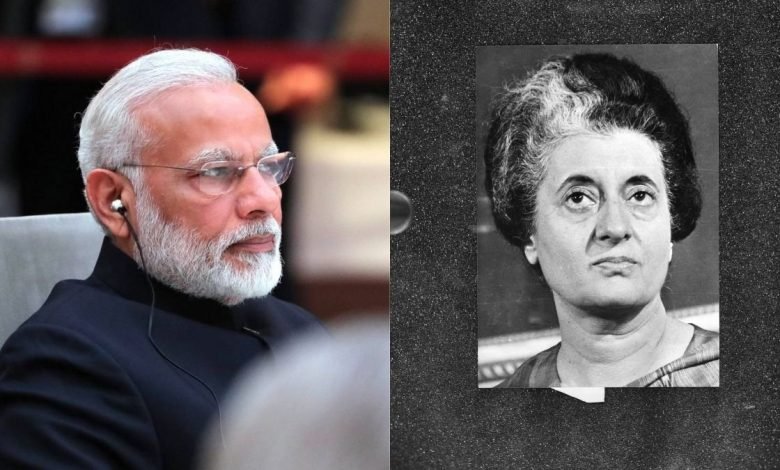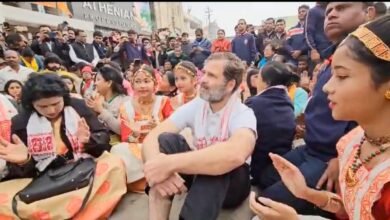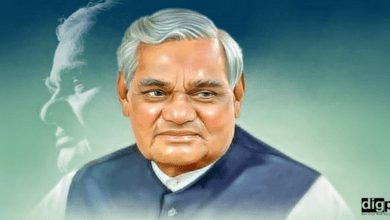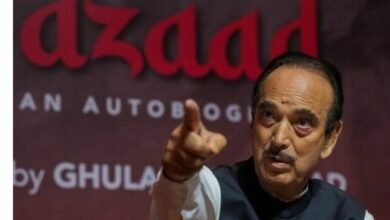Indira Gandhi and Narendra Modi: More Alike Than Different?

There is a sameness to the personas of Indira Gandhi and Narendra Modi rather than them being the complete opposite.
One of the most widely used defenses over the past seven years by the current Indian Prime Minister towards any kind of criticism he receives has been to “Blame it on Congress” (Nehru-Indira). Let’s revisit the fiery speeches of Narendra Modi before the 2014 elections, which can be majorly attributed to the resurrection of the BJP. Not a single one of them is without the PM invoking either Nehru or Gandhi.
However, when we look at Narendra Modi’s rule in the last seven years as the Prime Minister of India, the story displays a totally different angle. The persona of Indira Gandhi, the PM, and Narendra Modi, the PM, look more alike than they look different. There is an affinity in their conduct rather than them being the complete opposite of each other. Are you surprised with the comparison and the conclusion of similarity? Well, we are not and here are more reasons than one:
Self Comes First, and the Constitution Comes Second (or doesn’t come at all)
Indira Gandhi has the most significant number of Amendments to the constitution and the law of the land to her credit. This was done for a variety of reasons, like granting more power to the Central Government and stopping people from speaking out against the government by arresting citizens’ freedom, but it was mostly done to consolidate the ideology and the position of Gandhi. The Cabinet of Indira Gandhi often came to know about her decisions after they had been executed, Emergency and bank nationalization being two important ones.
Narendra Modi, as the Prime Minister of India, has been shown to behave in a similar way, if not worse. Passing bills without discussion has become more like a norm than an exception to the extent of even the Union Budget being passed without any deliberations by the Parliament.
Desiring of a Complicit Judicial and Military Structure
During the reign of a socialist ideology-oriented Indira, it was ensured that the judiciary and the military remain on her side and on the side of the constitution as it is supposed to be.
The elevation of Justice A N Ray to the post of Chief Justice of India bypassing three people in line before him and a position on top of the line for men in uniform close to the former Chief Minister was ways of achieving undying loyalty from two institutions that are supposed to be unbiased and uninfluenced in a thriving democracy.
This “show of love” from the Prime Minister and her administration was repaid in the best of ways, exactly how Indira expected. When India was reeling from the darkest periods of its democratic history as the Indira Gandhi government announced an Emergency, the detention of a person was held to be under judicial purview even during an Emergency by not one, two, or three but nine High Courts of the Country. However, when the matter reached the Indira faithful Supreme Court, Justice Ray opined otherwise and turned the judgments over. (the habeas corpus case)
Skip to the current point in time under the Prime Ministership of Narendra Modi. In a first-of-its-kind incident, Judges from the Supreme Court of India addressed a press conference expressly talk about government pressure. Before this incident, former Chief Justice, Justice Tirath Singh Thakur openly pointed out how Justice Kuttiyil Mathew Joseph was denied a position in the Apex court due to his critical government judgments.
Like Indira, Modi also promoted his loyal Gen. Bipin Rawat well before his time and is reaping the benefits of his politico-military positioning in Kashmir. Achieving a subservient and complicit Judiciary as well as Army.
Mocking Democratic Institutions
One of the stark similarities between how Indira ruled and how Modi is ruling is how the Election Commission of India was treated and then and how it is treated now. Much like in the current era of Modi-Shah, India’s apex election administration body was in the good books of Indira Gandhi. And the institution and its caretakers managed to maintain this position as she remained in power.
Another democratic institution that both Modi and Indira have used as their dog on a leash is the Central Bureau of Investigation (coupled with the Enforcement Directorate). In ways to intimidate and silence their critics and the opposition, the CBI and ED were a potent weapon in the armory of Indira as they are in Modi’s. However, the only difference is that Congress was dealing the blows then, and BJP was receiving them without there being much that they could do in retaliation, much like the current day Congress.
The sole purpose of making sure that all the democratic institutions become subservient and faithful to the PMO for Indira was and for Modi is to make every toe their line and serve their agenda. This is the prime reason that the otherwise good motive moves like the Bank Nationalization and Demonetization still had an adversarial ring, and the authoritative streak in those decisions led to avoidable controversies and criticism.
The Head of the Republic and Heads of States ‘Good Friends’ with the PM
The sameness in the way Indira used Governors in the states during her time and Modi is doing it is so evident and loud that it almost looks like Modi did not just take a leaf out of the former’s book hijacked the book itself.
While Indira toyed with state governments on flimsy grounds in the cases of Ajoy Mukherjee’s United Front government in West Bengal in 1969 and N.T Rama Rao’s government in Andhra Pradesh in 1984, Modi toyed with the ethos of Democracy itself in Goa, Manipur, Meghalaya, and Nagaland.
In these states, the BJP came to power despite having failed to emerge as the single largest party after the elections. But when it came to Karnataka and Congress had the chance to do the same, Narendra Modi used his “Good Friend,” his highness the Governor of Karnataka, to make sure that the BJP, which had emerged as the single largest party, forms the government.
In terms of Presidents, the Head of the Republic, Indira, appointed Giani Zail Singh, who was infamously known to hold open the car door for her while being the Constitutional Head of the Country. Her other appointment was Fakhruddin Ali Ahmed, who welcomed the 19-month long Emergency with open arms.
Similarly, all the Narendra Modi appointed Presidents have been BJP loyalists along with a BJP loyalist Vice-President.
Lack of Regard for Citizens’ Freedom or its Absence Thereof
What can be a better textbook proof of Indira Gandhi’s lack of regard for freedom of the press in particular and citizens’ political freedom in general than her declaration of the unprecedented Emergency? The Indira Government was infamous for keeping students under check by unleashing terror on campuses in the mid-1970s.
Although Narendra Modi and his government are yet to declare an emergency, their attacks on Press Freedom and students have been relentless and untiring. Starting with making the much-needed RTI Act almost a good-for-nothing piece of legislation by denying information on the grounds of sensitivity and national interests, Modi has made sure that the socio-political tension between communities remains at its peak at all times.
Where Indira unleashed the terror of “forced sterilization of men” under the Modi government, love jihad, Ghar wapsi and lynchings have been popularized. This has been coupled with radical attacks on institutions like the Jawaharlal Nehru University, Allahabad University, Hyderabad Central University, Jamia Millia Islamia, and the Aligarh Muslim University.
A Larger-than-Life Persona that Overshadows Even the Country
One thing that undeniably unites Indira and Modi is their persona. Both the people have managed to make themselves so big that everything else fades in the background, even the country’s welfare.
Here are a few slogans used by Indira and Modi:
“They want Indira out; I want poverty out” (Indira Gandhi)
“If there is Modi; There is a possibility” (Narendra Modi)
“Indira is India; India is Indira” (Indira Gandhi)
“Modi hain to mumkin hain” (Narendra Modi)







